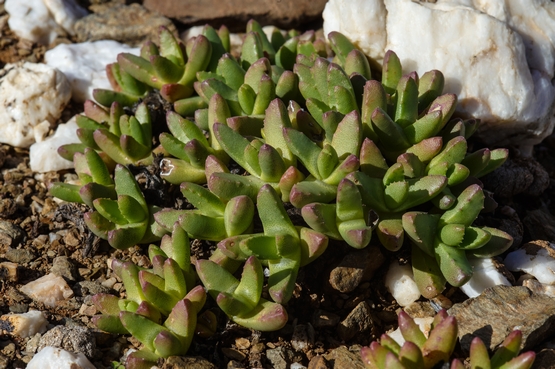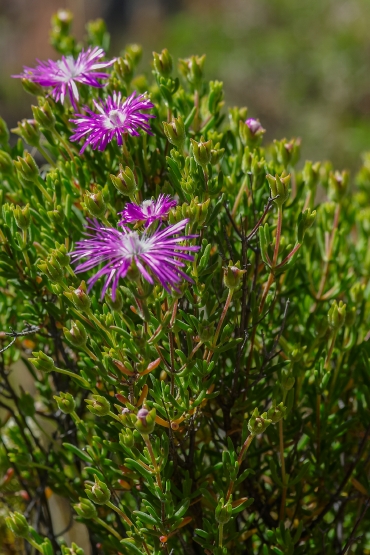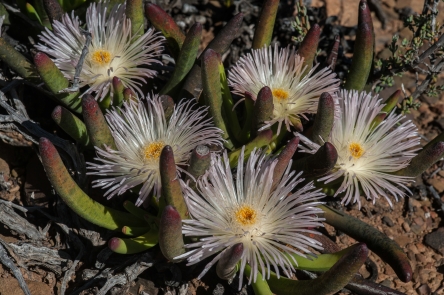For the first time ever, I came across this species in the wild last week. It was growing along the road leading to the back entrance of the Anysberg Nature Reserve, northeast of Montagu.
The species is only recorded from the Montagu and Swellendam districts, where it grows in crevices in shale and sandstone. It differs from all other Glottiphyllums because of the pointed, upright leaves.
Tag: Little Karoo
Drosanthemum speciosum
These plants, which may become up to 80 cm tall, are locally abundant from Worcester to Barrydale in the western Little Karoo and are often seen along roads.
The many flowers are about 5 cm across and usually flaming scarlet or red, although more subtle orangey colours also occur; they are present in late winter and spring (May-October).
In the next post I will show you some more flowers, photographed in a somewhat different way.
Stomatium suricatinum
Senecio scaposus
This species is found sporadically from Montagu eastwards to the Eastern Cape, usually on rocky outcrops. The leaves are covered in silvery grey felt, protecting the plant against desiccation.
The first picture was taken southwest of Ladismith, the second one northwest of the same town and the last one at the foot the Rooiberg near Calitzdorp.
Quaqua pillansii
It seemed appropriate to devote this first post from my new home to a plant that was first discovered near Montagu. Nowadays it is known to be widely distributed from just south of Ceres to the area north of Port Elizabeth. In a genus where most plants look rather dull when not in flower, this is probably the most handsome. It is a robust species, forming shrubs of almost half a meter tall and even more in diameter. (The only Quaqua that is occasionally bigger is Q. mammillaris). In spite of their size, the plants are not always very easy to find. The shape and mottling of the stems provide a nice camouflage.
The two plants in habitat were photographed in early November at the northern foot of the Rooiberg pass near Calitzdorp. The flowering plant is a cultivated one.
Euphorbia tridentata
Drosanthemum duplessiae
Coming to terms: panicle
In the first installment of”Coming to terms” (28 June), I discussed an type of inflorescence called a raceme. Today’s post is about a kind of “super raceme” called a panicle. This is a raceme with side-branches which in turn are also racemes.
The plant chosen as an example is Aloe perfoliata (A. comptonii), flowering on the Rooiberg plateau south of Calitzdorp 6 October 2012.
Depth of field and atmosphere in plant photography

As a rule I use a diaphragm of f/16 when photographing plants, because it usually gives the best combination of sharpness and Depth of Field. After taking this picture of Euphorbia pseudoglobosa last Sunday, I wondered what the result would be if I used the lens’s full opening. The result is shown below. Both pictures have their merits, but to me the second one is more interesting as it imparts a brooding atmosphere and a feeling of loneliness. I would be interested to hear your opinion.

































